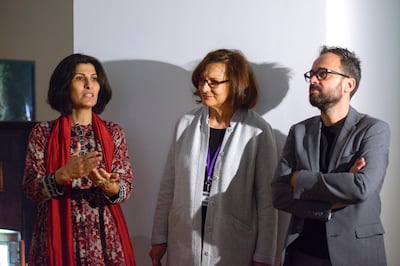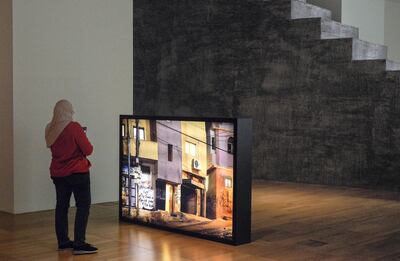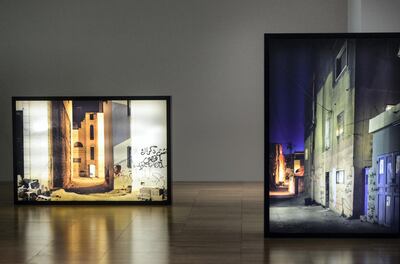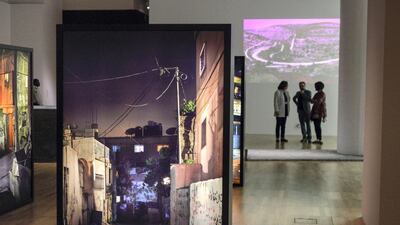In what curator Salwa Mikdadi calls the "euphoria" following the 1993 Oslo Peace Accords, construction began on a Palestinian Parliament building that the Palestinian Legislative Council could call home. Building started in Abu Dis, a suburb of Jerusalem. But as construction continued, a video from the artwork Common Assembly explains, the cartographer Khalil Tufakji noticed that the 1967 border ran smack in the middle of the Parliament, halving the very symbol of Palestinian representation.
The line bisected houses, too – one family entered their front door in occupied Jerusalem but slept in East Jerusalem – and had generally been drawn either with disregard for events on the ground, or with the knowledge of its contested position. Soon, even that line was disregarded and the Parliament building was abandoned in 2003 during the Second Intifada.
This story, exemplary of the complexity of the Palestinian-Israeli conflict, is brought to life in the work Common Assembly (2011), part of the New York University Abu Dhabi Art Gallery's exhibition of work by the artist-architect duo Sandi Hilal and Alessandro Petti.
Titled Permanent Temporariness, it is the fullest retrospective of their work to date, and is curated by Mikdadi, a professor of art history at NYUAD, and Bana Kattan, a curator at the Art Gallery. Mikdadi has long engaged with Hilal and Petti's work – she was the first curator of a Palestinian pavilion at the Venice Biennale, and one of the works she commissioned, their sound piece Ramallah Syndrome (2009), is also included in the show.

Hilal and Petti, who worked in Palestine for many years and now live in Sweden, investigate the real living conditions in the refugee camps – a state they call "permanent temporariness". This aims to acknowledge the fact that what appears to be a temporary state of Palestinian exile has now been drawn out for 70 years, with people's whole lives spent stranded in limbo within the refugee camps.
This, as Hilal explained in a talk before the show’s opening on Saturday, affects not only the mindset of those in the camp, but also what can be built there: a fine balance is struck between ameliorations of life there and improvements that might edge conditions from temporary to permanent, relinquishing the hold on the right to return.
While in Palestine, Hilal and Petti, working with others, initiated a number of projects aiming to increase knowledge; “Campus for Camps” for example, which started in 2012, is the first university in a refugee camp.
Their current project – Refugee Heritage (2018) – is a collaboratively assembled bid for the Dheisheh camp in Bethlehem to be considered a Unesco World Heritage Site, as it is the oldest refugee camp on the planet (it was the first to be established after 1948). For this show, they commissioned photographer Luca Capuano to capture the site with the attention to World Heritage Sites such as Venice – where they met as architecture students – and these brooding, night images are arranged within light boxes around the gallery. To prove their point about the beauty the camp can take on, there is also an image of Venice visitors are invited to spot.

A line of concrete, in a stepped V connecting the walls of the gallery, refers to the line that runs through the abandoned Palestinian Parliament. Its thickness is proportional to its size on local maps, and it wends upwards, as if taking in the stepped seating and tables of the parliament room it bisects. Running straight through one of the gallery’s pillars, the line’s sense of inconvenient bifurcation is clear. But it also evokes a public space for sitting, as on the steps of museums in cities, and the gallery indeed allows visitors to sit and pause there.
One of Hilal and Petti’s main ideas is this sense of a “commons” rather than a “public”, countering the idea, as Petti puts it, “as if nothing exists in-between the public and the private”. “The commons is a collective space that’s not public,” he explains, rather than like a private university’s gallery functioning as a public space, or, indeed, the way a refugee camp resident could feel their camps belonged to them, although they might never have a chance to own the land.
This idea of a "commons" space also motivates their latest project, Al Madhafah / The Living Room (2018), the "living room" that they instituted in Boden, in the north of Sweden, which is the first point of entry for many refugees to the country. They recreated it at NYUAD in some sessions in advance of the show. (It was one of a number of works that extended beyond the gallery space and into the wider campus.)
Al Madhafah thinks about the living room as this interstitial space between public and private – the public rooms of a private house – and which refugees in camps or in new countries have typically used for ad-hoc courts, when forums for these activities are not offered by the state, or which, through the kind of cultural norms and even food offered, carry a sense of a home country into the host one. "The commons," Petti says, "needs the activation of the people. People transform a site into a site held in common." When they leave it, it is only a room again.

Petti and Hilal's work is often called social practice work, or even activism, which suggests their physical artworks are somehow less important than the research preceding them, or the ends the project will achieve. But I found this exhibition to be incredibly sensitive to the work's aesthetic resolution and to the way that bodies encounter objects and move through space – results, most likely, of Hilal and Petti's training in architecture.
In Mujawara / The Tree School (2014), a work that was first shown at the 31st São Paulo Biennial, an earthen ball is suspended above visitors' heads. In it grows a ghaf tree, the national tree of the United Arab Emirates. The choice of tree is adapted for each exhibition's environment: in Sao Paulo, it was a baobab tree, which comes from a children's book written by Campus in Camps and the Brazilian Grupo Contrafilé. In the book, a baobab tree that has been displaced from Africa to Brazil mourns its native soil. But once it returns to Africa, it realises it misses Brazil too: the book leaves the ending unresolved for each child to interpret.
_____________________
Read more:
‘Lifescapes Beyond Bigness’ explores connection between human life and landscapes
Alessandro Balteo-Yazbeck examines who the refugee crisis benefits
NYUAD exhibition shows life from a migrants' perspective
_____________________
Kattan, whose parents are Palestinian (like Mikdadi's and Hilal's – all three women who put together this show grew up in exile), but who was raised in Abu Dhabi, explains that in the Emirates "some of the first schools in the desert took place under the ghaf trees". The installation recreates the idea of a place of discourse opening up under the tree, but is also threatening as it hangs overhead. Capuano's light boxes form alleyways one must manoeuvre, evoking snaking through a city that has arisen without, or despite of, top-down regulations.
The show is also a straightforward assessment of a political situation which receives waning attention. It is also urgently topical, with the refugee crisis in Syria and elsewhere mounting rather than abating. “When we started this show, the Syrian refugee situation was not as it is,” says Kattan. “I cannot imagine a more important show to do.”
Permanent Temporariness is at the NYUAD Art Gallery until June 9, 12pm to 8pm, except Sundays. For more, see www.nyuad-artgallery.org


